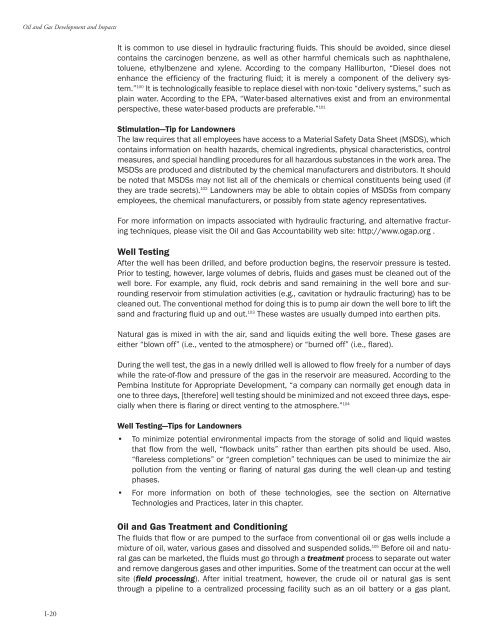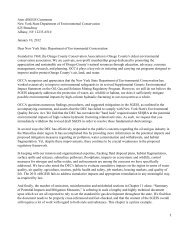Oil and Gas at Your Door? (2005 Edition) - Earthworks
Oil and Gas at Your Door? (2005 Edition) - Earthworks
Oil and Gas at Your Door? (2005 Edition) - Earthworks
You also want an ePaper? Increase the reach of your titles
YUMPU automatically turns print PDFs into web optimized ePapers that Google loves.
<strong>Oil</strong> <strong>and</strong> <strong>Gas</strong> Development <strong>and</strong> Impacts<br />
It is common to use diesel in hydraulic fracturing fluids. This should be avoided, since diesel<br />
contains the carcinogen benzene, as well as other harmful chemicals such as naphthalene,<br />
toluene, ethylbenzene <strong>and</strong> xylene. According to the company Halliburton, “Diesel does not<br />
enhance the efficiency of the fracturing fluid; it is merely a component of the delivery system.”<br />
100 It is technologically feasible to replace diesel with non-toxic “delivery systems,” such as<br />
plain w<strong>at</strong>er. According to the EPA, “W<strong>at</strong>er-based altern<strong>at</strong>ives exist <strong>and</strong> from an environmental<br />
perspective, these w<strong>at</strong>er-based products are preferable.” 101<br />
Stimul<strong>at</strong>ion—Tip for L<strong>and</strong>owners<br />
The law requires th<strong>at</strong> all employees have access to a M<strong>at</strong>erial Safety D<strong>at</strong>a Sheet (MSDS), which<br />
contains inform<strong>at</strong>ion on health hazards, chemical ingredients, physical characteristics, control<br />
measures, <strong>and</strong> special h<strong>and</strong>ling procedures for all hazardous substances in the work area. The<br />
MSDSs are produced <strong>and</strong> distributed by the chemical manufacturers <strong>and</strong> distributors. It should<br />
be noted th<strong>at</strong> MSDSs may not list all of the chemicals or chemical constituents being used (if<br />
they are trade secrets). 102 L<strong>and</strong>owners may be able to obtain copies of MSDSs from company<br />
employees, the chemical manufacturers, or possibly from st<strong>at</strong>e agency represent<strong>at</strong>ives.<br />
For more inform<strong>at</strong>ion on impacts associ<strong>at</strong>ed with hydraulic fracturing, <strong>and</strong> altern<strong>at</strong>ive fracturing<br />
techniques, please visit the <strong>Oil</strong> <strong>and</strong> <strong>Gas</strong> Accountability web site: http://www.ogap.org .<br />
Well Testing<br />
After the well has been drilled, <strong>and</strong> before production begins, the reservoir pressure is tested.<br />
Prior to testing, however, large volumes of debris, fluids <strong>and</strong> gases must be cleaned out of the<br />
well bore. For example, any fluid, rock debris <strong>and</strong> s<strong>and</strong> remaining in the well bore <strong>and</strong> surrounding<br />
reservoir from stimul<strong>at</strong>ion activities (e.g., cavit<strong>at</strong>ion or hydraulic fracturing) has to be<br />
cleaned out. The conventional method for doing this is to pump air down the well bore to lift the<br />
s<strong>and</strong> <strong>and</strong> fracturing fluid up <strong>and</strong> out. 103 These wastes are usually dumped into earthen pits.<br />
N<strong>at</strong>ural gas is mixed in with the air, s<strong>and</strong> <strong>and</strong> liquids exiting the well bore. These gases are<br />
either “blown off” (i.e., vented to the <strong>at</strong>mosphere) or “burned off” (i.e., flared).<br />
During the well test, the gas in a newly drilled well is allowed to flow freely for a number of days<br />
while the r<strong>at</strong>e-of-flow <strong>and</strong> pressure of the gas in the reservoir are measured. According to the<br />
Pembina Institute for Appropri<strong>at</strong>e Development, “a company can normally get enough d<strong>at</strong>a in<br />
one to three days, [therefore] well testing should be minimized <strong>and</strong> not exceed three days, especially<br />
when there is flaring or direct venting to the <strong>at</strong>mosphere.” 104<br />
Well Testing—Tips for L<strong>and</strong>owners<br />
• To minimize potential environmental impacts from the storage of solid <strong>and</strong> liquid wastes<br />
th<strong>at</strong> flow from the well, “flowback units” r<strong>at</strong>her than earthen pits should be used. Also,<br />
“flareless completions” or “green completion” techniques can be used to minimize the air<br />
pollution from the venting or flaring of n<strong>at</strong>ural gas during the well clean-up <strong>and</strong> testing<br />
phases.<br />
• For more inform<strong>at</strong>ion on both of these technologies, see the section on Altern<strong>at</strong>ive<br />
Technologies <strong>and</strong> Practices, l<strong>at</strong>er in this chapter.<br />
<strong>Oil</strong> <strong>and</strong> <strong>Gas</strong> Tre<strong>at</strong>ment <strong>and</strong> Conditioning<br />
The fluids th<strong>at</strong> flow or are pumped to the surface from conventional oil or gas wells include a<br />
mixture of oil, w<strong>at</strong>er, various gases <strong>and</strong> dissolved <strong>and</strong> suspended solids. 105 Before oil <strong>and</strong> n<strong>at</strong>ural<br />
gas can be marketed, the fluids must go through a tre<strong>at</strong>ment process to separ<strong>at</strong>e out w<strong>at</strong>er<br />
<strong>and</strong> remove dangerous gases <strong>and</strong> other impurities. Some of the tre<strong>at</strong>ment can occur <strong>at</strong> the well<br />
site (field processing). After initial tre<strong>at</strong>ment, however, the crude oil or n<strong>at</strong>ural gas is sent<br />
through a pipeline to a centralized processing facility such as an oil b<strong>at</strong>tery or a gas plant.<br />
I-20




